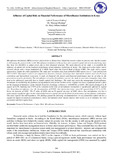Influence of Capital Risk on Financial Performance of Microfinance Institutions in Kenya
Date
2023-09-27Author
Temesi, Godfrey Ashiali
Musiega, Maniagi
Sindani, Mary Nelima
Metadata
Show full item recordAbstract
Microfinance Institutions (MFIs) services and activities in Kenya have helped the country reduce its poverty rate, but the country is still among the poorest in the world. Microfinance institutions in Kenya have also reported capital risk in terms of pricing since they have less flexibility to adjust prices due to their financial structure. The main objective of the study is to establishthe influence of capital risk on the financial performance of microfinance institutions in Kenya. The study used a descriptive survey research design with a target population of 12 MFIs listed under the Central Bank of Kenya (CBK). The study used a census approach to sample the entire population. The study used secondary data from published CBK reports over a 7-year period from 2015 to 2021. Descriptive statistics are comprised of skewness, kurtosis, and jarque bera. Inferential statistics used were Pearson correlation and hierarchical regression. A study on financial risk factors and financial performance may be of value to the government in policy formation. The microfinance act policy formulators can use the study to ascertain contagious issues thatneed to be addressed, especially how to handle capital risk challenges. The study may assist the management of microfinance institutions in establishing the problems facing financial risk factors in their sector. Capital risk had a significant positive effect on the financial performance of the Nairobi Securities Exchange in Kenya (t =0.0346763, p<0.05). This model produced an R square of 0.378, implying that 3.78% of the variation in the risks of microfinance institutions is significantly affected by capital risk. Regarding microfinance size, the incorporation of IV*MV, thus interaction terms, moved R squared from 0.337 to 0.378,hence an increase of 0.041. The P value of 0.024 and an R squared increase of 0.041 showsthat microfinance size has a moderatingly significant effect on the relationship between capital risk and the financial performance of microfinance institutions. The study rejected the null hypothesis. The findings guided the following recommendations: Itwas found that capital risk has a significant impact on financial performance; hence, microfinance firms should improve their assets so as to minimize the risks associated with their capital base.
URI
https://doi.org/10.51867/ajernet.4.2.39https://ajernet.net/ojs/index.php/ajernet/article/view/122/101
http://ir-library.mmust.ac.ke:8080/xmlui/handle/123456789/2330
Collections
- Gold Collection [996]

